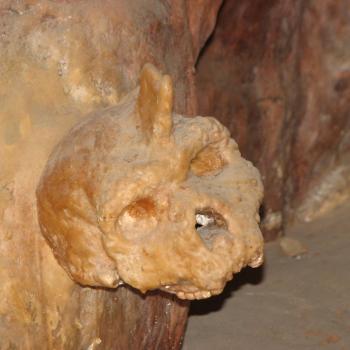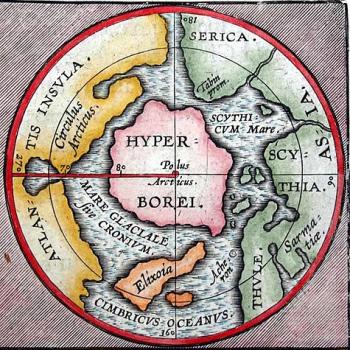On April 22, 1978, a lightning strike hit Jamaica’s National Stadium as Bob Marley sang at the One Love Concert, held to calm the political violence raging between presidential candidates Edward Seaga and Michael Manley.
The thunderbolt came as Marley was inviting Seaga and Manley to the stage, where moments later the reggae superstar created an iconic image by joining the two bitter enemies’ hands above his own head. The timing of the thunderbolt resonated with religious beliefs held by the band and the audience stretching back to Yoruba in West Africa and beyond.

Origins of lightning symbolism
Written about 3,800 years ago, Hindu texts describe Lord Indra wielding a trident that generates lightning bolts against his enemies. Storm gods in the Near East also used a lightning-generating trident in battle.
In a mythic tale about the onset of the spring rainy season, Lord Indra goes into battle with his trident against a dragon who’s hoarded all the world’s water. Lord Indra slits the dragon’s belly with a bolt of lightning and the rainy season begins.
It’s impossible to know the true age of the archetypal thunder god, but he appears across cultures, often as a creator god. The thunder god of the Dinka in southern Sudan was Deng, who carried a club that generated lightning. In West Africa the Yoruba god Shango carried a double-headed ax. The Norse thunder-god Thor carried a hammer.
Ancient and indigenous cultures associated the onset of spring thunderstorms with the arrival of migratory birds and conjured a cross-cultural deity known as the Thunderbird, often a creator god. The mythic bird made thunder with its wings and flashed lightning from its eyes or talons.
A new meaning for lightning
In Tibetan tradition, the peace-loving Buddha took Lord Indra’s trident and bent its prongs together to form a scepter. The power of lightning was no longer destructive but instead bestowed instant spiritual transformation, destroying ignorance with divine energy.
Tibetan Buddhists call the scepter the vajra chopper, often used by the female deity Naropa Vajrayogini to transform base emotions into divine qualities. In Old Path White Clouds (1992, Parallax Press), Thich Nhat Hanh wrote of the Buddha’s Great Awakening in the context of a storm, when “thunder crashed, and great bolts of lightning flashed across the sky as if to rip the heavens in two.”

About 550 years later a Jewish Rabbi named Saul was traveling to Damascus when a “great light” appeared with a vision from heaven, knocking Saul to the ground and and temporarily blinding him. Although he was passionately opposed to the new Christian religion, Saul changed his name, became an apostle of Jesus and ultimately was canonized as Saint Paul.
Just 600 years ago the Mayans held similar beliefs reflected in statuary that depicts a king being transformed into a god with a flint ax embedded in his forehead. The Mayans believed lightning transformed rock into flint, which illuminated the mind of the newly minted god. Similar beliefs are found among Native Americans.
In Black Elk: The Sacred Ways of a Lakota (1991, HarperOne), Wallace Black Elk described deities traveling in lightning. “So the spirits say that Tunkashila, the power, is a lightning. There is a trail alongside this lightning. We travel, we run and walk, alongside the lightning. So there are trails alongside the clouds. … ”
The role of lightning across religions is similar to the effects a lightning strike can sometimes have on the brain. Those who aren’t killed by the strike itself may show a wide range of symptoms, including profound changes in personality. Mary Ann Cooper, now retired from the University of Illinois at Chicago, studied the subject for more than 30 years and believes lightning can permanently change how a body’s cells behave, and can effectively short-circuit parts of the brain.
Yoruba, Shango and Rastafarianism
In West Africa, the Yoruba pantheon of gods includes Shango, who punishes thieves and liars but also bestows spiritual awareness with lightning bolts from his double-bladed ax.
A large percentage of the Africans stolen from West Africa and sold into slavery in the Caribbean were Yoruba and their traditions traveled with them. In Trinidad a hybrid religion developed known as Trinidad Orisha or Shango, focused on a personal connection with god through trance-dancing.

The influence of Yoruba is also found in Rastafarianism, which emerged in Jamaica more than a century ago based heavily on the Old Testament – a Rastafarian sees god, Jesus and all his apostles as black Ethiopians. Like both Shango and Saint Paul, a bolt of lightning would play a spiritual role in the story of Bob Marley, the musician, singer and social activist who achieved international fame in the 1970s.
From the beginning, Rastas stood opposed to the material gain and human greed embodied in the Old Testament history of Babylon, reflected in the modern cruelty and oppression of colonialism. Rastas separated themselves from white society, refused to attend Christian schools and engaged in a tradition of squatting, arguing that only God can own the land. Part of their effort to separate was to grow their hair into long matted locks or dreadlocks, giving them a “dread appearance.”
Vegetarian Rastas don’t fry vegetables
In From Garvey to Marley: Rastafari Theology (2007 University Press of Florida), Noel Leo Erskine wrote that Rastafarians seek a personal connection with god, often through smoking cannabis but also in their diet.
Livity is the word for eating and living right and ganja is the holy herb or wisdom seed. Rastas are nature-loving vegetarians, only eating meat in the form of small herring known as sprat. Fish over a foot long are considered predators and agents of Babylon. Rasta don’t smoke tobacco, eat processed foods, use pesticides, drink alcohol or fry vegetables, which they eat raw or roasted.
Marcus Garvey was the first proponent of Rastafarianism in the 1920s, and often used stormy imagery.
“No one knoweth when the hour of Africa’s redemption cometh. It is in the wind. It is coming. One day, like a storm, it will be here,” wrote Garvey. “We have gradually won our way back into the confidence of the God of Africa, and he shall speak with the voice of thunder, that shall shake the pillars of a corrupt and unjust world … ”
Erskine wrote, “As often as judgment is pronounced (by Rastas) on Babylon or the agents of Babylon they will call on nature to assist: ‘May lightning and thunder strike the downpressors.’”
A thunderbolt at One Love Concert
In the middle of another violent Jamaican election season in 1978, Marley was asked to headline the One Love Concert in Jamaica’s National Stadium. At one point Marley invited presidential candidates Manley and Seaga on stage, singing, “I just want to shake hands and show the people that we gonna mean it right.”
As Marley waited for the two bitter enemies to come on stage he continued singing about love and unity and at one point scatted a series of staccato exclamations – git, git, git, git, gaah! – and jumped in the air to mark the end of the vocal line. At that moment lightning struck somewhere behind the stage – the loud thunderclap shook the camera, which recorded two bright flashes of light.
The band continued to play as Marley responded to the lightning strike with spasmodic dancing. The body language and smiles of the band members showed they understood how meaningful the thunderbolt had been. Moments later Marley was standing between Seaga and Manley, joining their hands together over his head in the now-iconic image.
The rationally inclined will dismiss the lightning strike as coincidence, but Marley and the band and much of the audience perceived it as heavenly recognition of the singer’s effort to transform heated emotion into divine qualities of peace and compassion.
The vajra chopper was at work.
Another lightning strike

Longtime back-up singer for Bob Marley and the Wailers, Judy Mowatt told of a lightning strike in 1981, this one occurring when Marley died of cancer at the age of 36.
“A lightning bolt came through my window and lodged for about a second on Bob’s picture. That was before the radio stations reported he had died. I think the heavens were really responding to a great force being taken away from the physical plane of the earth,” said Mowatt.
The One Love Concert and Mowatt’s interview are in the 1986 documentary The Bob Marley Story: Caribbean Nights, produced by the BBC and Island Records. The film includes an interview with Marley’s mother, who spoke about his white father and how Marley was ostracized as a boy. The film ends with the long and joyful funeral train that took Marley’s body back to the countryside, kicking up dirt around the corners on the way to the village where he was born.
(Ben H. Gagnon is an award-winning journalist and author of Church of Birds: an eco-history of myth and religion, to be released March 31 from John Hunt Publishing, now available for pre-order. More information is found at this website, which links to a YouTube video.)
















